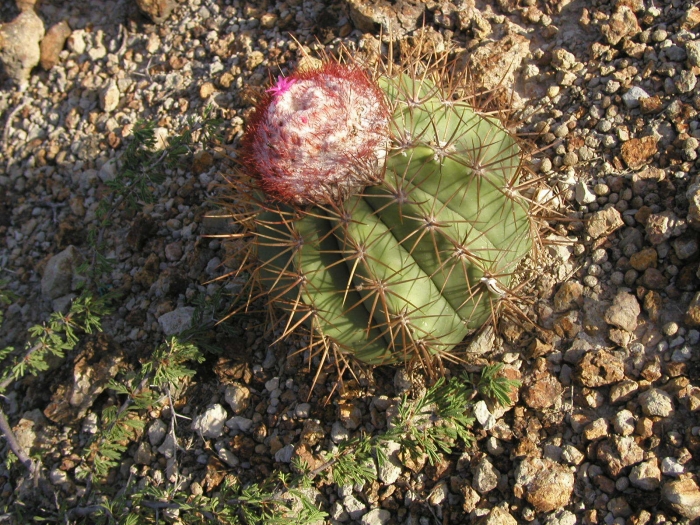Turk’s Cap Cactus
(Melocactus curvispinus)
Turk’s Cap Cactus (Melocactus curvispinus)
/
/

desertnaturalist
CC BY 4.0
Image By:
desertnaturalist
Recorded By:
Copyright:
CC BY 4.0
Copyright Notice:
Photo by: desertnaturalist | License Type: CC BY 4.0 | License URL: http://creativecommons.org/licenses/by/4.0/ | Rights Holder: desertnaturalist | Publisher: iNaturalist | Date Created: 37840 |

























Estimated Native Range
Summary
Melocactus curvispinus, commonly known as the Turk’s cap cactus, is a perennial succulent native to arid and semi-arid regions in the southern Mexico, the Caribbean, Venezuela, and Colombia. It thrives in rocky and sandy soils where other vegetation is sparse. This cactus typically grows to a height of up to 12 inches (30 cm) and features a globular, green to blue-green body with 8 to 14 pronounced ribs lined with curved spines. The cephalium, a woolly and bristly cap-like structure, develops after several years and is a key characteristic of mature plants. From this structure, small pink to reddish flowers emerge, usually during the warmer months. The flowers are not particularly showy but are of interest due to their unique position atop the cephalium.
The Turk’s cap cactus is favored in cultivation for its distinctive appearance and low maintenance requirements. It is often grown in cacti and succulent collections, rock gardens, and as a container plant for patios or indoor settings. It requires full sun exposure to maintain its compact shape and vibrant coloration. Watering should be minimal, allowing the soil to dry out completely between waterings, and the plant must be in well-drained soil to prevent root rot. While it is generally free of serious pests and diseases, overwatering can lead to fungal issues.CC BY-SA 4.0
The Turk’s cap cactus is favored in cultivation for its distinctive appearance and low maintenance requirements. It is often grown in cacti and succulent collections, rock gardens, and as a container plant for patios or indoor settings. It requires full sun exposure to maintain its compact shape and vibrant coloration. Watering should be minimal, allowing the soil to dry out completely between waterings, and the plant must be in well-drained soil to prevent root rot. While it is generally free of serious pests and diseases, overwatering can lead to fungal issues.CC BY-SA 4.0
Plant Description
- Plant Type: Succulents
- Height: 1-2 feet
- Width: 1-1.5 feet
- Growth Rate: Slow
- Flower Color: Pink
- Flowering Season: Summer
- Leaf Retention: Evergreen
Growth Requirements
- Sun: Full Sun
- Water: Very Low
- Drainage: Fast
Common Uses
Low Maintenance, Potted Plant, Rock Garden
Natural Habitat
native to arid and semi-arid regions in the southern Mexico, the Caribbean, Venezuela, and Colombia
Other Names
Common Names: Melon Cactus
Scientific Names: Melocactus curvispinus , Melocactus curvispinus , Melocactus delessertianus
GBIF Accepted Name: